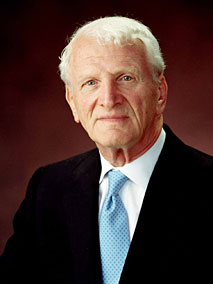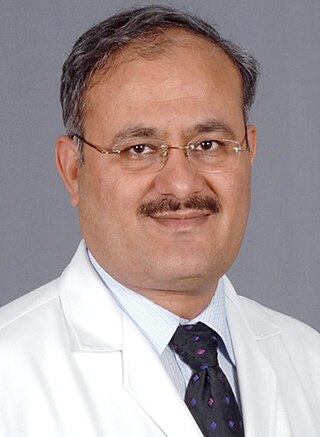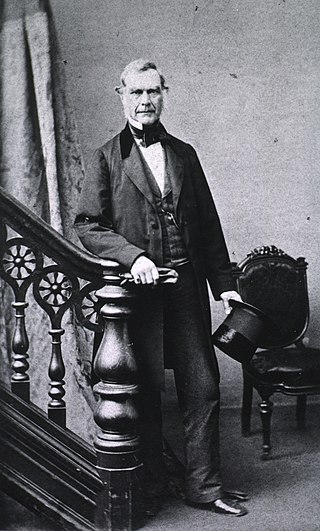
Ophthalmology is a surgical subspecialty within medicine that deals with the diagnosis and treatment of eye disorders. A former term is oculism.

Massachusetts General Hospital is the original and largest teaching hospital of Harvard Medical School, Harvard University located in the West End neighborhood of Boston, Massachusetts. Massachusetts General Hospital houses the world's largest hospital-based research program, the Mass General Research Institute, with an annual research budget of more than $1.2 billion in 2021. It is the third-oldest general hospital in the United States with a patient capacity of 999 beds. Along with Brigham and Women's Hospital, Mass General is a founding member of Mass General Brigham, formerly known as Partners HealthCare, the largest healthcare provider in Massachusetts. It is currently ranked among the best hospitals in the United States by U.S. News & World Report.

Mass General Brigham is a not-for-profit, integrated health care system that is a national leader in medical research, teaching, and patient care. It is the largest hospital-based research enterprise in the United States, with annual funding of more than $2 billion. The system's annual revenue was nearly $18 billion in 2022. It is also an educational institution, founded by Brigham and Women's Hospital and Massachusetts General Hospital. The system provides clinical care through two academic hospitals, three specialty hospitals, seven community hospitals, home care services, a health insurance plan, and a robust network of specialty practices, urgent care facilities, and outpatient clinics/surgical centers. It is the largest private employer in Massachusetts. In 2023, the system reported that from 2017–2021 its overall economic impact was $53.4 billion – more than the annual state budget.

New York Eye and Ear Infirmary of Mount Sinai (NYEE) is located at East 14th Street and Second Avenue in lower Manhattan, New York City. Founded on August 14, 1820, NYEE is America's first specialty hospital and one of the most prominent in the fields of ophthalmology and otolaryngology in the world, providing primary inpatient and outpatient care in those specialties. Previously affiliated with New York Medical College, as of 2013 it is affiliated with the Icahn School of Medicine at Mount Sinai as a part of the membership in the Mount Sinai Health System.
The Illinois Eye & Ear Infirmary (IEEI) is a center of ophthalmology and otolaryngology research and clinical practice.
Paul T. Finger, MD, FACS, is an ophthalmologist in New York, New York, specializing in ocular oncology. Finger is a Clinical Professor of Ophthalmology at the New York University School of Medicine in New York City, New York. He is also the director of The New York Eye Cancer Center and Ocular Tumor Services at The New York Eye and Ear Infirmary of Mt. Sinai. He consults for Northwell Health Complex of affiliated Hospitals including Manhattan Eye, Ear and Throat Hospital and NYU School of Medicine. He is Chair of the Ophthalmic Oncology Task Force for the American Joint Committee on Cancer (AJCC), wrote the eye cancer staging systems section for the Union International for Cancer Control (UICC). As Chair, he brought together an OOTF to develop consensus eye plaque radiation guidelines for The American Brachytherapy Society - American Association of Physicists in Medicine. Dr. Finger was the first the only ophthalmologist asked to serve on the 2012 American Association of Physicists in Medicine’s Task Group-129 that produced both dosimetry and quality assurance standards for plaque brachytherapy. As of 2021, Dr. Finger has authored over 335 peer-review scientific articles, 2 books, 54 book chapters and 2 web sites.

The University of Illinois Hospital & Health Sciences System is a member of the Illinois Medical District, one of the largest urban healthcare, educational, research, and technology districts in the USA. The University of Illinois Hospital & Health Sciences System itself is composed of the 485-bed University of Illinois Hospital, outpatient diagnostic and specialty clinics, and two Federally Qualified Health Centers (FQHCs) that serve as primary teaching facilities for the University of Illinois at Chicago (UIC) Health Science Colleges. The eight-story inpatient facility provides patient care services from primary care through and including transplantation, with a medical staff in a variety of specialties. In 1999, the 245,000-square-foot (22,800 m2) Outpatient Care Center (OCC) opened with a fully computerized medical record system, allowing patient records to be accessible electronically. The OCC houses all subspecialty and general medicine outpatient services and the Women's Health Center.
The ÇOMÜ Hospital is the biggest research and teaching hospital in the Western Marmara region of Turkey which serves the area of north Aegean and South-West Marmara regions. The current president and chief executive officer is Dr. Murat Coşar. The hospital is a 160-bed facility that provides patients with a complete range of primary and specialty care services.
The American Osteopathic Boards of Ophthalmology and Otolaryngology - Head and Neck Surgery (AOBOO) is a joint organization that provides board certification to qualified Doctors of Osteopathic Medicine (D.O.) who specialize in the medical and surgical treatment of the eye (ophthalmologists) and to qualified Doctors of Osteopathic Medicine who specialize in the medical and surgical treatment of the ears, nose, and throat (otolaryngologists). The boards belong to the 18 medical specialty certifying boards approved by the American Osteopathic Association Bureau of Osteopathic Specialists of the American Osteopathic Association. As of December 2011, 736 osteopathic ophthalmologists and otolaryngologists held active certification with the AOBOO.

Reza Dana is the Claes H. Dohlman Professor of Ophthalmology, senior scientist and W. Clement Stone Clinical Research Scholar at Massachusetts Eye and Ear, Harvard Medical School, and director of the Harvard-Vision Clinical Scientist Development Program.

Eugene Nicholas Myers is an oncologist and otolaryngologist and a leader in the treatment of head and neck cancer. He has served on the faculty of the University of Pittsburgh School of Medicine since 1972, when he became chairman of the Department of Otolaryngology. He is the author or co-author of leading texts in the field of head and neck cancer, and has chaired and served on the boards of the preeminent societies and associations in the field.

TheRoyal Victorian Eye and Ear Hospital is a specialist public teaching hospital in East Melbourne, Australia. It is the only hospital in Australia which specialises in both ophthalmology and otolaryngology.
Perry Rosenthal, was a Canadian-born American eye surgeon and professor of ophthalmology, known for his work in the development of the first gas-permeable scleral contact lens.
Joan Whitten Miller is a Canadian-American ophthalmologist and scientist who has made notable contributions to the treatment and understanding of eye disorders. She is credited for developing photodynamic therapy (PDT) with verteporfin (Visudyne), the first pharmacologic therapy for retinal disease. She also co-discovered the role of vascular endothelial growth factor (VEGF) in eye disease and demonstrated the therapeutic potential of VEGF inhibitors, forming the scientific basis of anti-VEGF therapy for age-related macular degeneration (AMD), diabetic retinopathy, and related conditions.
Charles Stephen Foster is an American ophthalmologist known for his research and treatment of ocular inflammatory disease (OID) with immunomodulatory therapy. In addition, Foster is the author of approximately 1,000 papers and 14 textbooks. His focus tends to be dedicated to the advancement of ophthalmology. Foster established the Ocular Immunology and Uveitis Foundation to support relevant research. He is currently is a mentor and part-time professor of ophthalmology at Harvard Medical School.

Virender Singh Sangwan is an Indian ophthalmologist and the Dr. Paul Dubord Chair professor and director of the L. V. Prasad Eye Institute, Hyderabad. Known for his research on limbal stem cells, Sangwan is the founder secretary and an adviser of the Uveitis Society of India. The Council of Scientific and Industrial Research, the apex agency of the Government of India for scientific research, awarded him the Shanti Swarup Bhatnagar Prize for Science and Technology, one of the highest Indian science awards for his contributions to Medical Sciences in 2006.
Santosh Gajanan Honavar is an Indian ophthalmologist and is currently the Honorary General Secretary of the All India Ophthalmological Society; Director of Medical Services ; Director, Department of Ocular Oncology and Oculoplasty at Centre for Sight, Hyderabad; and Director, National Retinoblastoma Foundation. He was the Editor of the Indian Journal of Ophthalmology and Indian Journal of Ophthalmology - Case Reports, the official journals of the All India Ophthalmological Society from 2017 to 2023.

Daniel M. Albert is an American ophthalmologist, ocular cancer researcher, medical historian, and collector of rare books and ocular equipment. As of 2018, he is Professor of Ophthalmology at the Casey Eye Institute, Oregon Health & Science University.

John Jeffries II was an American ophthalmic surgeon who co-founded the Massachusetts Charitable Eye and Ear Infirmary in 1824 with Edward Reynolds. This organization, which began life as the Boston Eye Infirmary, became officially incorporated in 1826 and maintained that name until 1924 when it became Massachusetts Eye and Ear. Jeffries and Reynolds were the only surgical staff until 1833 when the staff was expanded to include other assistant surgeons as well as an apothecary. Jeffries resigned from this position in 1842 and had no other official interaction with the institution until his son Benjamin was named Surgeon of the Infirmary in 1867.













